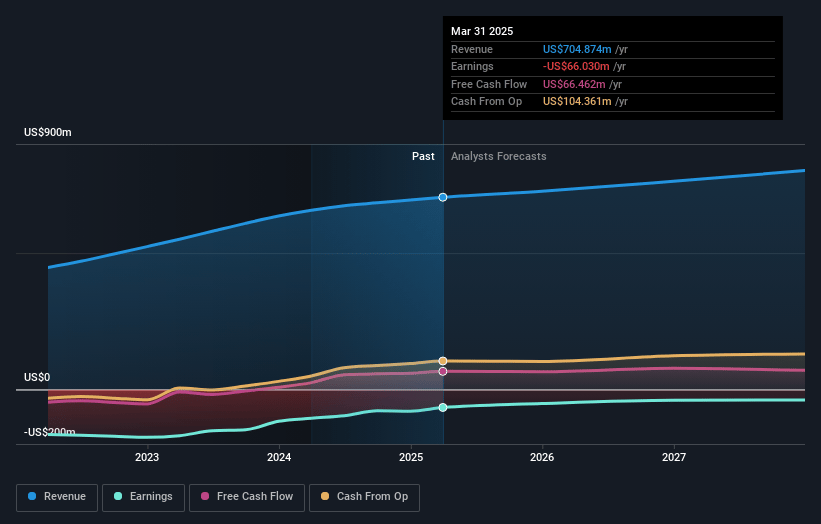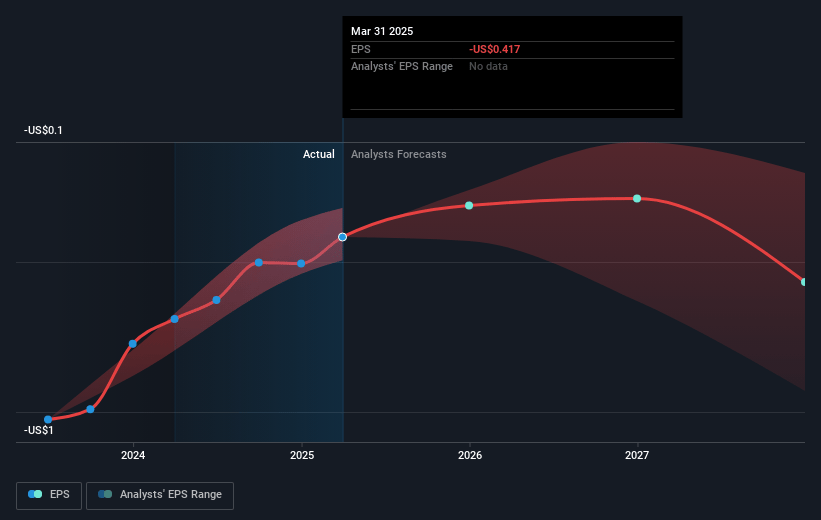Key Takeaways
- Expanded course offerings and AI-powered tools are set to drive increased learner engagement and international market penetration, boosting revenue.
- Strategic partnerships and segment integrations aim to enhance operational efficiency and marketability, potentially improving margins and driving growth.
- Global economic uncertainty and technological changes may impact Coursera's revenue growth across its enterprise, consumer, and academic segments.
Catalysts
About Coursera- Provides online educational services in the United States, Europe, Africa, the Asia Pacific, the Middle East, and internationally.
- Coursera's expansion of its course catalog and content partnerships, including new AI and industry-specific courses, is expected to drive increased learner engagement and course enrollments, which will positively impact revenue growth.
- With the integration of Consumer and Degrees segments, Coursera expects to streamline operations, improve learner experiences, and simplify offerings, potentially leading to higher efficiency and net margins.
- The introduction of AI-powered translation and course dubbing is likely to increase accessibility and engagement from non-English speaking markets, driving international revenue.
- Coursera's focus on accelerating product development cycles and leveraging data-driven insights aims to enhance user engagement and retention, potentially leading to improved earnings through higher customer lifetime value.
- Strategic partnerships with industry leaders (e.g., Microsoft, Google) are expected to boost the marketability of Coursera's offerings, attracting more learners and enterprise clients, which could drive revenue growth and improve profit margins through economies of scale.
Coursera Future Earnings and Revenue Growth
Assumptions
How have these above catalysts been quantified?- Analysts are assuming Coursera's revenue will grow by 4.7% annually over the next 3 years.
- Analysts are not forecasting that Coursera will become profitable in next 3 years. To represent the Analyst Price Target as a Future PE Valuation we will estimate Coursera's profit margin will increase from -9.4% to the average US Consumer Services industry of 11.6% in 3 years.
- If Coursera's profit margin were to converge on the industry average, you could expect earnings to reach $93.9 million (and earnings per share of $0.54) by about July 2028, up from $-66.0 million today.
- In order for the above numbers to justify the analysts price target, the company would need to trade at a PE ratio of 22.3x on those 2028 earnings, up from -21.8x today. This future PE is greater than the current PE for the US Consumer Services industry at 19.1x.
- Analysts expect the number of shares outstanding to grow by 2.86% per year for the next 3 years.
- To value all of this in today's terms, we will use a discount rate of 6.62%, as per the Simply Wall St company report.
Coursera Future Earnings Per Share Growth
Risks
What could happen that would invalidate this narrative?- The global macroeconomic uncertainty may cause enterprises to delay or reduce spending on upskilling and reskilling initiatives, potentially impacting Coursera's enterprise revenue growth.
- The competition and the rapid pace of technological changes may challenge Coursera to maintain its content relevance and innovation, potentially affecting the company's revenue and market share.
- The consumer sentiment is weakening, which could impact individual course enrollments and subscriptions, thereby affecting Coursera’s Consumer segment revenue.
- The decline in the Degrees product, as noted in the financial outlook, could result in reduced overall revenue growth for Coursera.
- External factors such as changes in government funding and policy shifts in higher education could negatively impact Coursera's partnerships and revenue from academic institutions.
Valuation
How have all the factors above been brought together to estimate a fair value?- The analysts have a consensus price target of $9.846 for Coursera based on their expectations of its future earnings growth, profit margins and other risk factors. However, there is a degree of disagreement amongst analysts, with the most bullish reporting a price target of $12.0, and the most bearish reporting a price target of just $7.0.
- In order for you to agree with the analyst's consensus, you'd need to believe that by 2028, revenues will be $808.9 million, earnings will come to $93.9 million, and it would be trading on a PE ratio of 22.3x, assuming you use a discount rate of 6.6%.
- Given the current share price of $8.92, the analyst price target of $9.85 is 9.4% higher.
- We always encourage you to reach your own conclusions though. So sense check these analyst numbers against your own assumptions and expectations based on your understanding of the business and what you believe is probable.
How well do narratives help inform your perspective?
Disclaimer
AnalystConsensusTarget is a tool utilizing a Large Language Model (LLM) that ingests data on consensus price targets, forecasted revenue and earnings figures, as well as the transcripts of earnings calls to produce qualitative analysis. The narratives produced by AnalystConsensusTarget are general in nature and are based solely on analyst data and publicly-available material published by the respective companies. These scenarios are not indicative of the company's future performance and are exploratory in nature. Simply Wall St has no position in the company(s) mentioned. Simply Wall St may provide the securities issuer or related entities with website advertising services for a fee, on an arm's length basis. These relationships have no impact on the way we conduct our business, the content we host, or how our content is served to users. The price targets and estimates used are consensus data, and do not constitute a recommendation to buy or sell any stock, and they do not take account of your objectives, or your financial situation. Note that AnalystConsensusTarget's analysis may not factor in the latest price-sensitive company announcements or qualitative material.
Read more narratives









